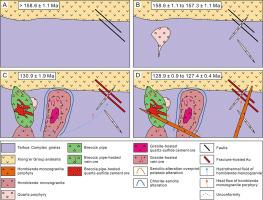当前位置:
X-MOL 学术
›
Ore Geol. Rev.
›
论文详情
Our official English website, www.x-mol.net, welcomes your
feedback! (Note: you will need to create a separate account there.)
The Qiyugou Au orefield — an intrusion-related gold system in the Eastern Qinling ore belt, China: Constraints from SIMS zircon U–Pb, molybdenite Re–Os, sericite 40Ar–39Ar geochronology, in-situ S–Pb isotopes, and mineralogy
Ore Geology Reviews ( IF 3.2 ) Pub Date : 2020-09-01 , DOI: 10.1016/j.oregeorev.2020.103636 Peng Wang , Jingwen Mao , Huishou Ye , Wei Jian , Xiaodan Chen , Yongfei Tian , Sheng He , Jianming Yan , Shaokui Wu , Limin Wan
Ore Geology Reviews ( IF 3.2 ) Pub Date : 2020-09-01 , DOI: 10.1016/j.oregeorev.2020.103636 Peng Wang , Jingwen Mao , Huishou Ye , Wei Jian , Xiaodan Chen , Yongfei Tian , Sheng He , Jianming Yan , Shaokui Wu , Limin Wan

|
Abstract The Eastern Qinling ore belt is the second largest Au province in China and is estimated to contain more than 1300 metric tons of Au. Most of the gold deposits in the belt are vein-type (fracture-hosted Au). Whether they are of metamorphic origin or magmatic-hydrothermal origin is controversial. The Qiyugou Au orefield developed granite-hosted Au, breccia pipe-hosted Au, and fracture-hosted Au, and the present study investigates these three types of gold mineralization. New zircon U–Pb and molybdenite Re–Os ages, along with previous published data, are used to constrain the ages of the three types of Au at about 131 Ma, corresponding to the emplacement age of hornblende monzogranite. S–Pb isotope compositions, telluride and Bi-sulfosalt minerals, hematite, alteration and metal zonation in the three types of Au suggest a common oxidized magmatic-hydrothermal origin. These results suggest an intrusion-related Au system in the Qiyugou Au orefield. This model confirms the magmatic-hydrothermal origin for the fracture-hosted Au, and provides important implications for further regional exploration.
更新日期:2020-09-01











































 京公网安备 11010802027423号
京公网安备 11010802027423号